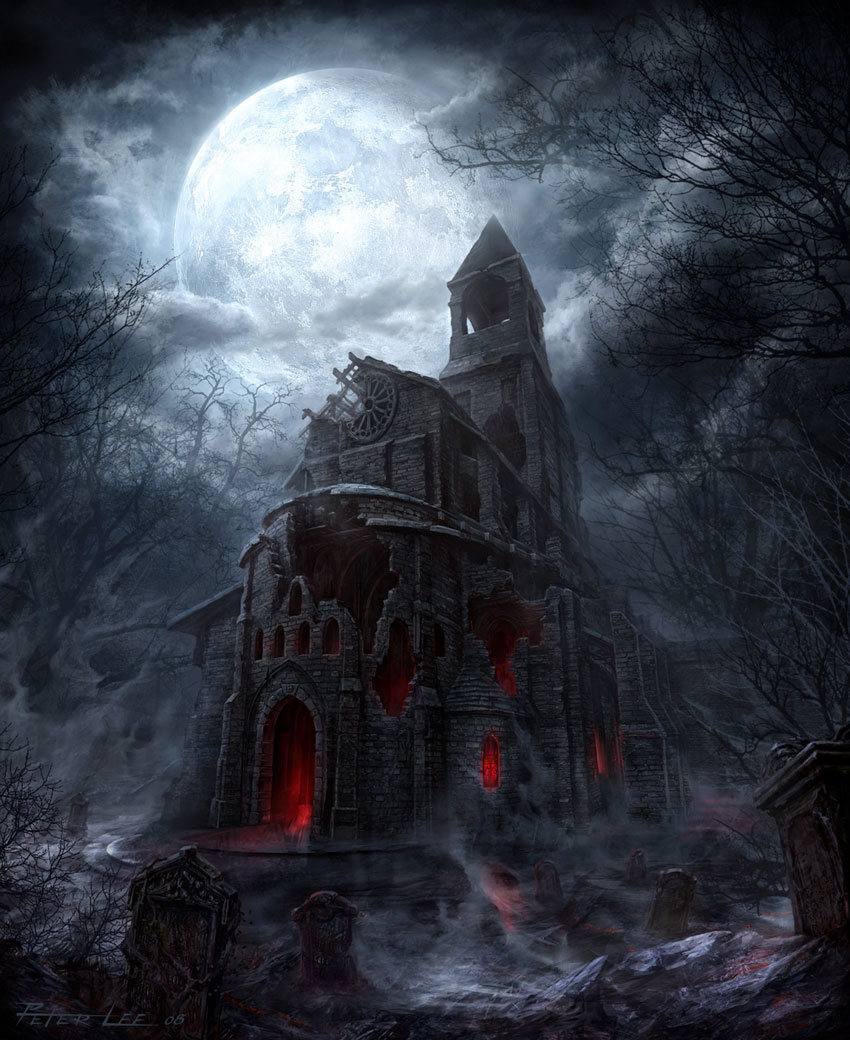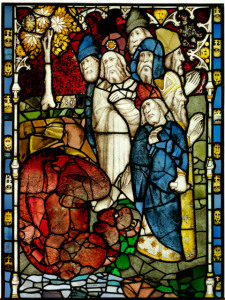
TRISTRAM CATHEDRAL- THE VIRTUAL ANTITHESIS OF SACRED SPACE
by Hannah Stamp on February 14th 2013. Can also be viewed on my previous blog: H does Heritage
“Stay awhile and listen…” For my research I am interested how computer games can be utilised to explore, interact with and interpret medieval architecture, secular, vernacular
and ecclesiastical, and how this technology can hinder, distort or benefit understanding of our heritage. I am going to start posting a few of my favourite in-game environments which
I admire for their artistic merit and how the architecture forms a dialogue with the heritage of the people who occupy the game. I am interested in how this reflects on our ideas of similar
locations in the real world and whether our interpretation and appreciation of heritage places are affected, good or bad, by popular culture with computer gaming in particular.
 Tristram Cathedral artwork by Peter Lee.
Tristram Cathedral from Blizzard’s action, RPG Diablo series (pictured above by Peter Lee) is one of the most beautiful, gothic architectural environments I have seen so far in gaming.
"Originally built as a Horadric monastery sometime around 912, the building was later converted to a Zakarum cathedral. Legend has it that the original
monastery was built over the vault where the mythical Diablo was imprisoned, and that his supposed release led to the horrors we all now associate with the name Tristram.
In order to shed light on the many mysteries of the old cathedral, I sought out an old adventurer who had braved its ancient passageways, which were said to lead to the Hells themselves.”
Abd al-Hazir (a renowned gentleman, historian, and scholar from Caldeum)
Although the Diablo games are not educational or representative of reality, Tristram Cathedral displays architectural vocabulary that can be found in our medieval cathedrals, for example,
its stone fabric and high gothic windows demonstrate divine power.
The fantasy of the game comes into play by twisting the once considered sacred architecture to symbolise darkness. There is an iconic quote by Samuel Taylor Coleridge
"The principle of the Gothic architecture is infinity made imaginable” yet this environment is contorted to represent the opposite, that gothic architecture can also be apocalyptic.
Tristram Cathedral, through its lighting, state of deterioration and possession of Diablo’s monsters is almost blasphemous in how it contorts this principle into a hellish vision of a
corrupted King who makes the Cathedral his seat of rulership. As a result for the people of Sanctuary, the social morale and faith in their religion declines. When we translate this
into the heritage of the real world, medieval churches and cathedrals often display horrific imagery in their stained glass, sculpture and wall painting, for example scenes of the
Apocalypse in York Minster’s East window (See below), or grotesques.
Tristram Cathedral artwork by Peter Lee.
Tristram Cathedral from Blizzard’s action, RPG Diablo series (pictured above by Peter Lee) is one of the most beautiful, gothic architectural environments I have seen so far in gaming.
"Originally built as a Horadric monastery sometime around 912, the building was later converted to a Zakarum cathedral. Legend has it that the original
monastery was built over the vault where the mythical Diablo was imprisoned, and that his supposed release led to the horrors we all now associate with the name Tristram.
In order to shed light on the many mysteries of the old cathedral, I sought out an old adventurer who had braved its ancient passageways, which were said to lead to the Hells themselves.”
Abd al-Hazir (a renowned gentleman, historian, and scholar from Caldeum)
Although the Diablo games are not educational or representative of reality, Tristram Cathedral displays architectural vocabulary that can be found in our medieval cathedrals, for example,
its stone fabric and high gothic windows demonstrate divine power.
The fantasy of the game comes into play by twisting the once considered sacred architecture to symbolise darkness. There is an iconic quote by Samuel Taylor Coleridge
"The principle of the Gothic architecture is infinity made imaginable” yet this environment is contorted to represent the opposite, that gothic architecture can also be apocalyptic.
Tristram Cathedral, through its lighting, state of deterioration and possession of Diablo’s monsters is almost blasphemous in how it contorts this principle into a hellish vision of a
corrupted King who makes the Cathedral his seat of rulership. As a result for the people of Sanctuary, the social morale and faith in their religion declines. When we translate this
into the heritage of the real world, medieval churches and cathedrals often display horrific imagery in their stained glass, sculpture and wall painting, for example scenes of the
Apocalypse in York Minster’s East window (See below), or grotesques.
 Apocalypse Scene in York Minster Stained Glass. Image Source:
York Press "Halfway stage in conservation of Great East Window in
York Minster"
Therefore, it is fascinating how popular culture often represents gothic as a virtual rearrangement of sacred space.
It’s vocabulary and characteristics tend to be rendered in an exaggerated, antithetical manner, for Tristram Cathedral in the gaming world is an architectural embodiment of evil and fear,
the complete opposite of what a cathedral is traditionally intended to symbolise.
Apocalypse Scene in York Minster Stained Glass. Image Source:
York Press "Halfway stage in conservation of Great East Window in
York Minster"
Therefore, it is fascinating how popular culture often represents gothic as a virtual rearrangement of sacred space.
It’s vocabulary and characteristics tend to be rendered in an exaggerated, antithetical manner, for Tristram Cathedral in the gaming world is an architectural embodiment of evil and fear,
the complete opposite of what a cathedral is traditionally intended to symbolise.
© 2019 Hannah Stamp
All website content, including the website itself, are © Hannah Stamp. All other content is copyright to it's respective owner.